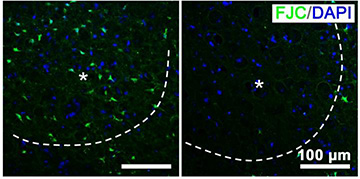![]()
A computerized tomography (CT) scan shows an absence of blood flow to the left brain, a sign of ischemic stroke. A technique combining upconversion nanoparticles and a photosynthetic bacterium could provide a new treatment for the disease. [Image: Getty Images]
Someone in the United States has a stroke every 40 seconds, with a death occurring every four minutes. The most common type of stroke, ischemic stroke, happens when the vessel that supplies oxygen-rich blood to the brain becomes blocked. Yet, while treatment options do exist, the majority of stroke patients receive medication that targets only downstream effects like inflammation, rather than the lack of oxygen itself.
Scientists at Huazhong University of Science and Technology, China, have investigated an unusual approach to treating ischemic stroke—one that combines photosynthetic bacteria and near-infrared light (Nano Lett., doi: 10.1021/acs.nanolett.1c00719). This “nanophotosynthesis” therapy generated oxygen while absorbing carbon dioxide in the brains of mice after stroke, allowing neurons to recover their function.
Reaching the brain
Previous research looked at the cyanobacterium S. elongatus for the treatment of myocardial ischemia, a condition that causes reduced blood flow and oxygenation to the heart. Cyanobacteria are a group of bacteria that produce and release oxygen as a byproduct of photosynthesis. To deliver the necessary light for photosynthesis to occur, however, the study required invasive surgery to open the chest of rats and expose the heart.
For the current study, the researchers came up with a different method that allowed them to irradiate the brain without cutting into the skull. Near-infrared light can more easily penetrate biological tissues, including bone, but it cannot be used to directly drive photosynthesis. So instead, the research team employed upconversion nanoparticles (UCNPs) to convert near-infrared light to the visible light needed for S. elongatus to generate oxygen.
Therapeutic impact
The researchers’ version of nanophotosynthesis therapy included a combination of neodymium-doped UCNPs and S. elongatus, which remained biocompatible with neuronal cells. When tested on a mouse with skull intact, near-infrared irradiation at 808 nm, converted by the UCNPs into wavelengths usable by the bacteria, successfully led to carbon dioxide consumption and oxygen production by S. elongatus.
Brain slices of mice that received nano-photosynthetic therapy (right) have fewer damaged neurons, shown in green, than control mice (left). [Image: adapted from Nano Letters 2021, doi: 10.10.21/acs.nanolett.1c00719] [Enlarge image]
Next, the researchers wanted to observe the effects of nanophotosynthesis therapy on damaged brain tissue after ischemic stroke. Mice with blocked cerebral arteries were given an injection of UCNPs and S. elongatus, then subjected to irradiation for 40 minutes. According to the team’s report, the nanophotosynthesis therapy improved brain tissue oxygenation and neuron survival and reduced the volume of dead tissue. It also promoted functional recovery in the mice, as seen with motor coordination and limb control tests.
Early-stage result
While the treatment is still in very early stages, the results suggest that nanophotosynthesis therapy could constitute a feasible treatment option for ischemic stroke. Biocompatibility tests performed by the researchers did not find any harmful effects of S. elongatus when combined with human neuronal cells. In addition, the presence of the cyanobacteria in living mice did not trigger an immune response.

